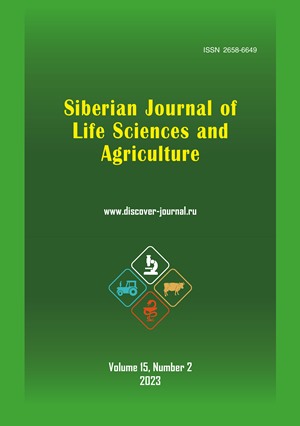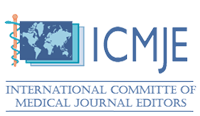ОСОБЕННОСТИ ИЗМЕНЕНИЯ МИКРОБИОТЫ СЛЮНЫ И ФЕКАЛИЙ У ПАЦИЕНТА С ДЕСМИНОПАТИЕЙ T341P
Аннотация
Обоснование. Десминопатии относятся к редким мышечным заболеваниям, вызываемых мутациями в гене DES. В настоящее время крайне малочисленны сведения об изменении микробиоты биологических сред у данных пациентов.
Цель. Изучить изменение микробиоты слюны и фекалий у пациента с десминопатией T341P в гетерозиготном состоянии.
Материалы и методы. В ретроспективное исследование вошло наблюдение пробанда с семейной формой десминопатии T341P. Количественный анализ 56 клинически значимых микроорганизмов осуществляли непосредственно в биологическом материале методом газовой хромато-масс-спектрометрии.
Результаты. С прогрессированием десминопатии в рассматриваемых биологических средах пробанда установлено появление вирусов Эпштейна-Барра, Herpes spp, цитомегаловируса и грамотрицательных палочек. Наблюдается избыточный бактериальный рост фекальной микробиоты и снижение микроорганизмов в слюне. Отмечается превышение нормы по суммарному количеству микроорганизмов и увеличение их видового разнообразия. Доминируют в кале Propionibacterium jensenii, Eubacterium spp, Eggerthella lenta, а в слюне – Clostridium ramosum. Установлено выраженное увеличение транзиторной микробиоты в кале с доминированием Peptostreptococcus anaerobius 18623, а также появление и стремительный рост в 441 раз потенциально опасной бактерии Clostridium difficile. Суммарный уровень эндотоксина в слюне и фекальной микробиоте пробанда возрастает и превышает норму соответственно в 13,7 и 81,8 раза. При этом отмечается низкий уровень плазмалогена.
Заключение. Результаты исследований в перспективе могут быть использованы для определения тактики комплексных вмешательств.
Скачивания
Литература
References
Kazarin D.D., Shklyaev A.E., Bolkiseva P.S., Petrova E.V. The use of a specific GSRS questionnaire for differential diagnosis of diseases of the gastrointestinal tract. Siberian Journal of Life Sciences and Agriculture, 2022, vol. 14, no. 1, pp. 163-180. https://doi.org/10.12731/2658-6649-2022-14-1-163-180
Shklyaev A.E., Grigorieva O.A., Merzlyakova Yu.S., Maksimov K.V., Kazarin D.D. Influence of eating behavior, fat distribution and physical activity on symptoms of functional gastrointestinal disorders. Siberian Journal of Life Sciences and Agriculture, 2021, vol. 13, no. 3, pp. 46-62. https://doi.org/10.12731/2658-6649-2021-13-3-46-62
Stavinskaya O.A., Dobrodeeva L.K., Patrakeeva V.P. Comparison of expression of immune responses depending on level of peripheral blood lymphocyte necrosis and apoptosis in humans. Siberian Journal of Life Sciences and Agriculture, 2021, vol. 13, no. 4, pp. 209-223. https://doi.org/10.12731/2658-6649-2021-13-4-209-223
Beltrán-Barrientos L.M., García H.S., Hernández-Mendoza A. et al. Invited review: Effect of antihypertensive fermented milks on gut microbiota. Journal of Dairy Science, 2021, vol. 104, no. 4, pp. 3779-3788. https://doi.org/10.3168/jds.2020-19466
Bescos R., Brookes Z.L., Belfield L.A. et al. Modulation of oral microbiota: A new frontier in exercise supplementation. PharmaNutrition, 2020, vol. 14, с. 100230. https://doi.org/10.1016/j.phanu.2020.100230
Cerdá B., Pérez M., Pérez-Santiago J.D. et al. Gut Microbiota Modification: Another Piece in the Puzzle of the Benefits of Physical Exercise in Health? Frontiers in physiology, 2016, vol. 7, p. 51. https://doi.org/10.3389/fphys.2016.00051
Clemen C.S., Herrmann H., Strelkov S.V., Schröder R. Desminopathies: pathology and mechanisms. Acta neuropathologica, 2013, vol. 125, no. 1, pp. 47-75. https://doi.org/10.1007/s00401-012-1057-6
Dort J., Fabre P., Molina T., Dumont N.A. Macrophages are key regulators of stem cells during skeletal muscle regeneration and diseases. Stem Cells international, 2019, vol. 2019, pp. 1-20. https://doi.org/10.1155/2019/4761427
Gizard F., Fernandez A., De Vadder F. Interactions between gut microbiota and skeletal muscle. Nutrition and Metabolic Insights, 2020, vol. 13, 1178638820980490. https://doi.org/10.1177/1178638820980490
González-Soltero R., Bailén M., de Lucas B. et al. Role of oral and gut microbiota in dietary nitrate metabolism and its impact on sports performance. Nutrients, 2020, vol. 12, no. 12, 3611. https://doi.org/10.3390/nu12123611
Kulikova O., Brodehl A., Kiseleva A. et al. The desmin (DES) mutation p. A337P is associated with left-ventricular non-compaction cardiomyopathy. Genes, 2021, vol. 12, no. 1, p. 121. https://doi.org/10.3390/genes12010121
Linsalata M., Riezzo G., D’Attoma B. et al. Noninvasive biomarkers of gut barrier function identify two subtypes of patients suffering from diarrhoea predominant-IBS: a case-control study. BMC gastroenterology, 2018, vol. 18, no. 1, pp. 1-14. https://doi.org/10.1186/s12876-018-0888-6
Osipov G., Verkhovtseva N. Study of human microecology by mass spectrometry of microbial markers. Beneficial microbes, 2011, vol. 2, no. 1, pp. 63-78. https://doi.org/10.3920/BM2010.0017
Osipov G.A., Boiko N.B., Fedosova N.F. et al. Comparative gas chromatography-mass spectrometry study of the composition of microbial chemical markers in feces. Microbial Ecology in Health and Disease, 2009, vol. 21, no. 3-4, pp. 159-171. https://doi.org/10.3109/08910600903462657
Pauls V.Yu. A review of clinical data of family form of myofibrillar desmin myopathy. Systematic Reviews in Pharmacy, 2019, vol. 10, no. 2, pp. 130-136. https://doi.org/10.5530/srp.2019.2.21
Pauls V.Yu. Change in redox status and biochemical parameters in patient with desminopathy T341P several years after disease symptoms onset. Journal of Pharmaceutical Negative Results, 2021, vol. 12, no. 2, pp. 24-28. https://doi.org/10.47750/pnr.2021.12.02.004
Pauls V.Yu. Dynamics of immune status in myofibrillar myopathy with the T341P DES mutation. Systematic Reviews in Pharmacy, 2020, vol. 11, no. 9, pp. 818-824. https://doi.org/10.31838/srp.2020.9.116
Peng X., Cheng L., You Y. et al. Oral microbiota in human systematic diseases. International Journal of Oral Science, 2022, vol. 14, no. 1, pp. 1-11. https://doi.org/10.1038/s41368-022-00163-7
Przewłócka K., Folwarski M., Kaźmierczak-Siedlecka K. et al. Gut-muscle axis exists and may affect skeletal muscle adaptation to training. Nutrients, 2020, vol. 12, no. 5, 1451. https://doi.org/10.3390/nu12051451
Ruppert T., Heckmann M.B., Rapti K. et al. AAV-mediated cardiac gene transfer of wild-type desmin in mouse models for recessive desminopathies. Gene therapy, 2020, vol. 27, no. 10, pp. 516-524. https://doi.org/10.1038/s41434-020-0147-7
Schröder R., Schoser B. Myofibrillar myopathies: a clinical and myopathological guide. Brain pathology, 2009, vol. 19, no. 3, pp. 483-492. https://doi.org/10.1111/j.1750-3639.2009.00289.x
Smits W.K., Lyras D., Lacy D.B. et al. Clostridium difficile infection. Nature reviews Disease primers, 2016, vol. 2, no. 1, pp. 1-20. https://doi.org/10.1038/nrdp.2016.20
Smolina N., Khudiakov A., Knyazeva A. et al. Desmin mutations result in mitochondrial dysfunction regardless of their aggregation properties. BBA-Molecular Basis of Disease, 2020, vol. 1866, no. 6, с. 165745. https://doi.org/10.1016/j.bbadis.2020.165745
Spörrer M., Kah D., Gerum R.C. et al. The desmin mutation R349P increases contractility and fragility of stem cell-generated muscle micro-tissues. Neuropathology and Applied Neurobiology, 2022, vol. 48, no. 3, e12784. https://doi org/10.1111/nan.12784
Thomas C., Minty M., Vinel A. et al. Oral microbiota: A major player in the diagnosis of systemic diseases. Diagnostics, 2021, vol. 11, no. 8, 1376. https://doi.org/10.3390/diagnostics11081376
Yoo J.Y., Groer M., Dutra S.V.O. et al. Gut microbiota and immune system interactions. Microorganisms, 2020, vol. 8, no. 10, 1587. https://doi.org/10.3390/microorganisms8101587
Список литературы
Казарин Д.Д., Шкляев А.Е., Болкисева П.С., Петрова Е.В. Применение специфического опросника GSRS для дифференциальной диагностики заболеваний органов пищеварения // Siberian Journal of Life Sciences and Agriculture. 2022. Т. 14, № 1. C. 163-180. https://doi.org/10.12731/2658-6649-2022-14-1-163-180
Шкляев А.Е., Григорьева О.А., Мерзлякова Ю.С., Максимов К.В., Казарин Д.Д. Влияние пищевого поведения, распределения жира и физической активности на симптомы функциональных гастроинтестинальных расстройств // Siberian Journal of Life Sciences and Agriculture. 2021. Т. 13, № 3. C. 46-62. https://doi.org/10.12731/2658-6649-2021-13-3-46-62
Ставинская О.А., Добродеева Л.К., Патракеева В.П. Влияние некроза и апоптоза лимфоцитов на выраженность иммунных реакций // Siberian Journal of Life Sciences and Agriculture. 2021. Т. 13, № 4. C. 209-223. https://doi.org/10.12731/2658-6649-2021-13-4-209-223
Beltrán-Barrientos L.M., García H.S., Hernández-Mendoza A. et al. Invited review: Effect of antihypertensive fermented milks on gut microbiota // Journal of Dairy Science. 2021. T. 104, №. 4. C. 3779-3788. https://doi.org/10.3168/jds.2020-19466
Bescos R., Brookes Z.L., Belfield L.A. et al. Modulation of oral microbiota: A new frontier in exercise supplementation // PharmaNutrition. 2020. T. 14. C. 100230. https://doi.org/10.1016/j.phanu.2020.100230
Cerdá B., Pérez M., Pérez-Santiago J.D. et al. Gut Microbiota Modification: Another Piece in the Puzzle of the Benefits of Physical Exercise in Health? // Frontiers in physiology. 2016. T. 7. C. 51. https://doi.org/10.3389/fphys.2016.00051
Clemen C.S., Herrmann H., Strelkov S.V., Schröder R. Desminopathies: pathology and mechanisms // Acta neuropathologica. 2013. T. 125, №. 1. C. 47-75. https://doi.org/10.1007/s00401-012-1057-6
Dort J., Fabre P., Molina T., Dumont N.A. Macrophages are key regulators of stem cells during skeletal muscle regeneration and diseases // Stem Cells international. 2019. T. 2019. C. 1-20. https://doi.org/10.1155/2019/4761427
Gizard F., Fernandez A., De Vadder F. Interactions between gut microbiota and skeletal muscle // Nutrition and Metabolic Insights. 2020. T. 13. C. 1178638820980490. https://doi.org/10.1177/1178638820980490
González-Soltero R., Bailén M., de Lucas B. et al. Role of oral and gut microbiota in dietary nitrate metabolism and its impact on sports performance // Nutrients. 2020. T. 12, №. 12. C. 3611. https://doi.org/10.3390/nu12123611
Kulikova O., Brodehl A., Kiseleva A. et al. The desmin (DES) mutation p. A337P is associated with left-ventricular non-compaction cardiomyopathy // Genes. 2021. T. 12, №. 1. C. 121. https://doi.org/10.3390/genes12010121
Linsalata M., Riezzo G., D’Attoma B. et al. Noninvasive biomarkers of gut barrier function identify two subtypes of patients suffering from diarrhoea predominant-IBS: a case-control study // BMC gastroenterology. 2018. T. 18, №. 1. C. 1-14. https://doi.org/10.1186/s12876-018-0888-6
Osipov G., Verkhovtseva N. Study of human microecology by mass spectrometry of microbial markers // Beneficial microbes. 2011. T. 2, №. 1. C. 63-78. https://doi.org/10.3920/BM2010.0017
Osipov G.A., Boiko N.B., Fedosova N.F. et al. Comparative gas chromatography-mass spectrometry study of the composition of microbial chemical markers in feces // Microbial Ecology in Health and Disease. 2009. T. 21, №. 3-4. C. 159-171. https://doi.org/10.3109/08910600903462657
Pauls V.Yu. A review of clinical data of family form of myofibrillar desmin myopathy // Systematic Reviews in Pharmacy. 2019. T. 10, №. 2. C. 130-136. https://doi.org/10.5530/srp.2019.2.21
Pauls V.Yu. Change in redox status and biochemical parameters in patient with desminopathy T341P several years after disease symptoms onset // Journal of Pharmaceutical Negative Results. 2021. T. 12, №. 2. C. 24-28. https://doi.org/10.47750/pnr.2021.12.02.004
Pauls V.Yu. Dynamics of immune status in myofibrillar myopathy with the T341P DES mutation // Systematic Reviews in Pharmacy. 2020. T. 11, №. 9. C. 818-824. https://doi.org/10.31838/srp.2020.9.116
Peng X., Cheng L., You Y. et al. Oral microbiota in human systematic diseases // International Journal of Oral Science. 2022. T. 14, №. 1. C. 1-11. https://doi.org/10.1038/s41368-022-00163-7
Przewłócka K., Folwarski M., Kaźmierczak-Siedlecka K. et al. Gut-muscle axis exists and may affect skeletal muscle adaptation to training // Nutrients. 2020. T. 12, №. 5. C. 1451. https://doi.org/10.3390/nu12051451
Ruppert T., Heckmann M.B., Rapti K. et al. AAV-mediated cardiac gene transfer of wild-type desmin in mouse models for recessive desminopathies // Gene therapy. 2020. T. 27, №. 10. C. 516-524. https://doi.org/10.1038/s41434-020-0147-7
Schröder R., Schoser B. Myofibrillar myopathies: a clinical and myopathological guide // Brain pathology. 2009. T. 19, №. 3. C. 483-492. https://doi.org/10.1111/j.1750-3639.2009.00289.x
Smits W.K., Lyras D., Lacy D.B. et al. Clostridium difficile infection // Nature reviews Disease primers. 2016. T. 2, №. 1. C. 1-20. https://doi.org/10.1038/nrdp.2016.20
Smolina N., Khudiakov A., Knyazeva A. et al. Desmin mutations result in mitochondrial dysfunction regardless of their aggregation properties // BBA-Molecular Basis of Disease. 2020. T. 1866, №. 6. C. 165745. https://doi.org/10.1016/j.bbadis.2020.165745
Spörrer M., Kah D., Gerum R.C. et al. The desmin mutation R349P increases contractility and fragility of stem cell-generated muscle micro-tissues // Neuropathology and Applied Neurobiology. 2022. T. 48, №. 3. C. e12784. https://doi.org/10.1111/nan.12784
Thomas C., Minty M., Vinel A. et al. Oral microbiota: A major player in the diagnosis of systemic diseases // Diagnostics. 2021. T. 11, №. 8. C. 1376. https://doi.org/10.3390/diagnostics11081376
Yoo J.Y., Groer M., Dutra S.V.O. et al. Gut microbiota and immune system interactions // Microorganisms. 2020. T. 8, №. 10. C. 1587. https://doi.org/10.3390/microorganisms8101587
Просмотров аннотации: 203 Загрузок PDF: 160
Copyright (c) 2023 Viacheslav Yu. Pauls

Это произведение доступно по лицензии Creative Commons «Attribution-NonCommercial-NoDerivatives» («Атрибуция — Некоммерческое использование — Без производных произведений») 4.0 Всемирная.






















































